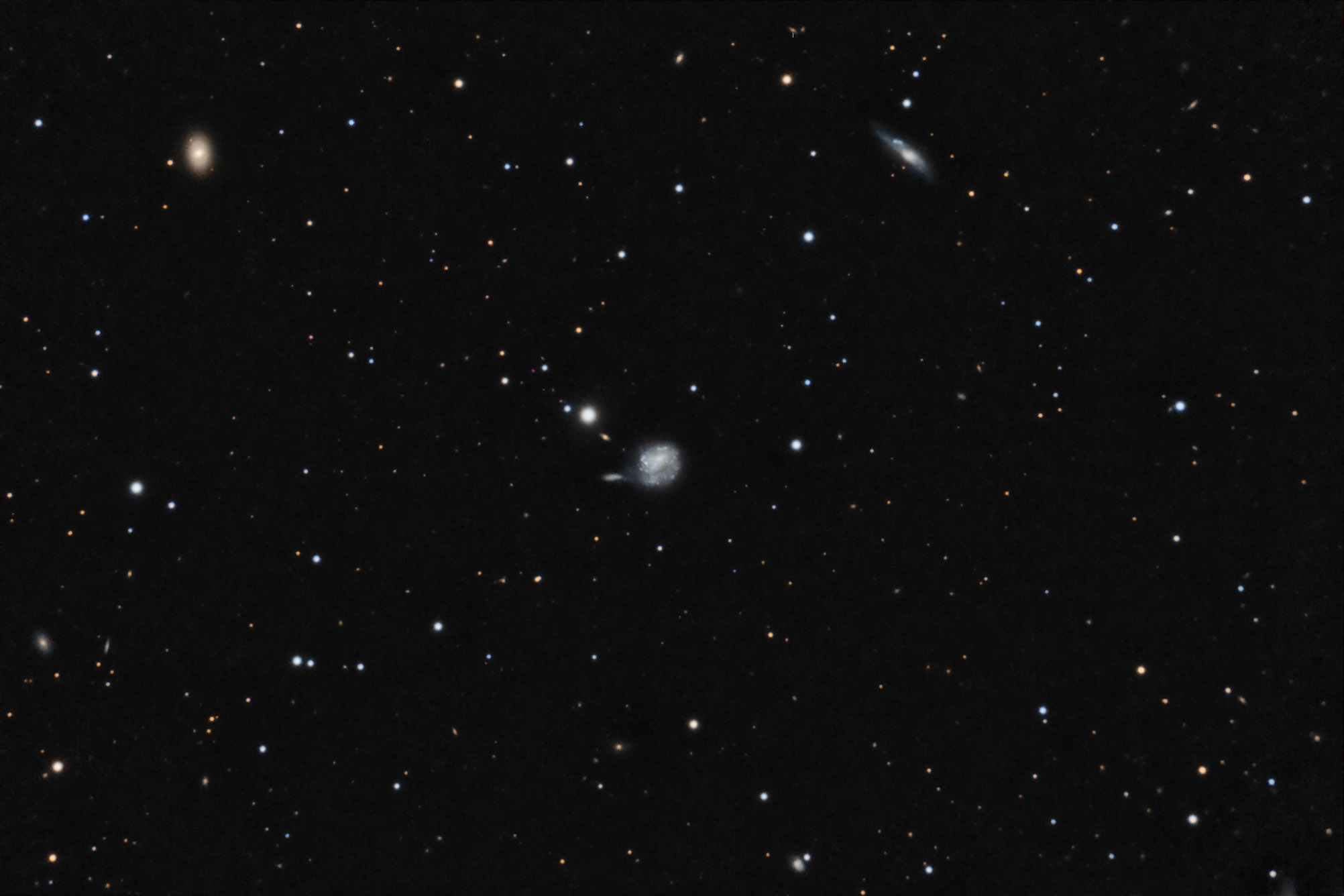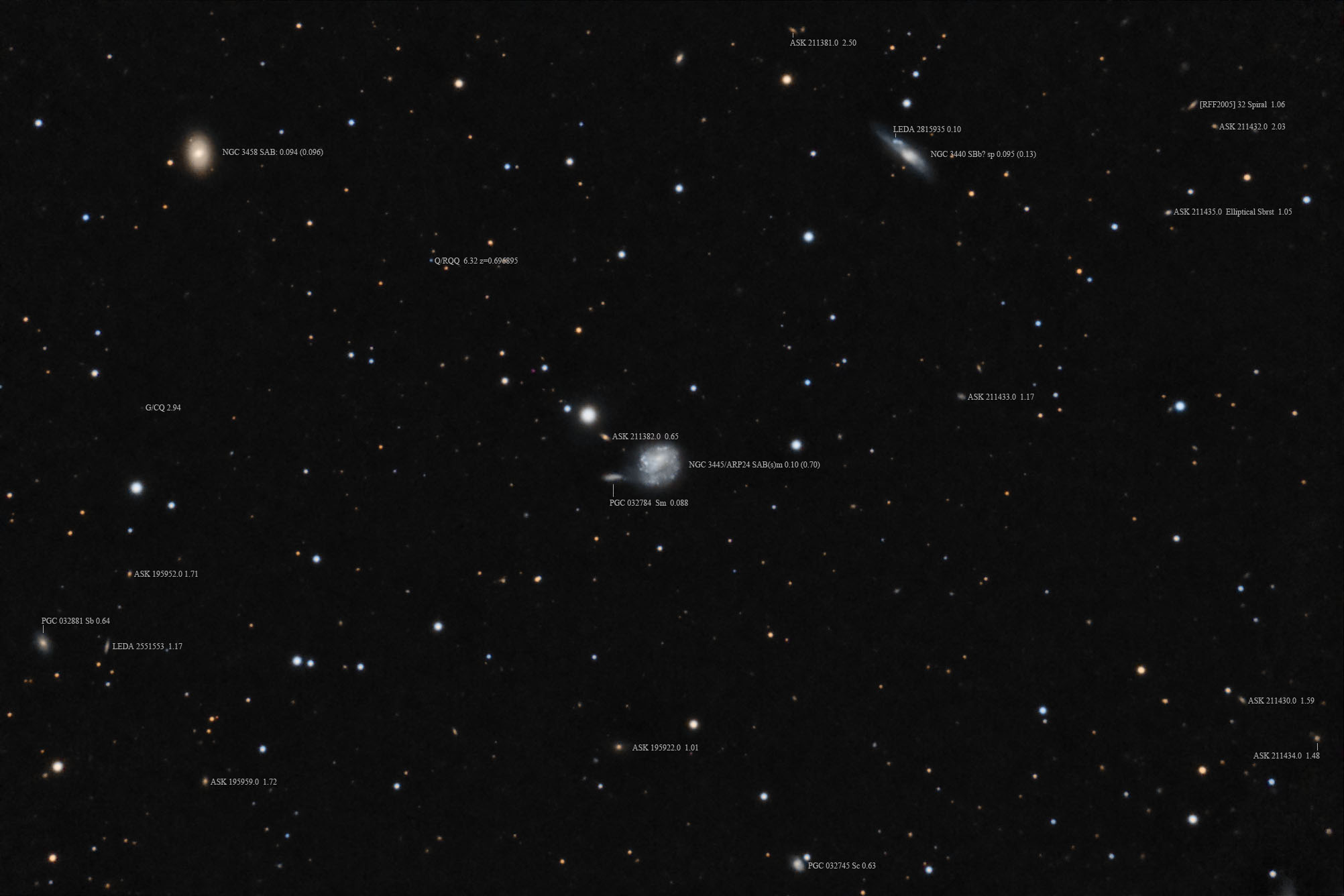| Description | Images |
Object name: ARP024Designation(s): ARP024, NGC3440, NGC3445, NGC3458, Arp 24/NGC 3445 is a galaxy Arp put in his one arm spiral category. It also would have fit in his spirals with large, high surface brightness companions. It is located in Ursa Major about 100 million light-years from us. NED classifies it as SAB(s)m, The NGC Project says Sc while Seligman says SBm?. It was discovered by William Herschel on April 8, 1793. Though isn't in either Herschel 400 observing programs. Its companion on the end of its lone arm is PGC 32784 at about the same distance by redshift. It seems connected to Arp 24 by a tidal plume coming from the single arm of Arp 24. Both NED and Seligman classify it as Sm. Seligman give its size as 9,000 light-years making it a dwarf galaxy. Seligman gives the size of Arp 24 as 35,000 light-years. Related Designation(s):10C J105437+565923, 1EX 023, 2EX 021, 2MASS J10543556+5659269, 2MASS J10560148+5707012, 2MASX J10534950+5707075, 2MASX J10543546+5659264, 2MASX J10560145+5707010, 7C 1051+5715, AKARI J1054358+565921, ARP 024, ARP 024 NED01, ARP 024:[CW2007] NUCLEUS, ARP024, CGCG 1050.7+5724, CGCG 1051.5+5715, CGCG 1053.0+5724, CGCG 291-009, CGCG 291-011, CGCG 291-014, CXO J105601.50+570702.5, GALEXASC J105601.49+570702.9 , GALEXMSC J105601.52+570702.0 , HDCE 0620 NED001, HDCE 0620 NED002, IRAS 10508+5722, IRAS 10515+5715, IRAS F10507+5723, IRAS F10515+5715, ISO_LHSS J105349+57070, KPG 256, KPG 256A, LDCE 0867 NED003, LDCE 0867 NED005, LGG 226:[G93] 001, LGG 226:[G93] 002, LGG 226:[G93] 003, LH J105349+570716, Lockman E4_1, MCG +10-16-019, MCG +10-16-023, MCG +10-16-026, NGC 3440, NGC 3445, NGC 3458, NGC 3458:[L2011a] X0001, NGC3440, NGC3445, NGC3458, NSA 138299, NSA 138322, NSA 138375, NVSS J105436+565921, PGC 032714, PGC 032772, PGC 032854, PiGSS J105435+565927, PLCKERC857 G149.59+53.66, SAFIRES J105349.42+570706.1, SAFIRES J105349.53+570706.7, SAFIRES J105435.14+565932.8, SAFIRES J105436.43+565926.3, SDSS J105349.48+570707.1, SDSS J105435.48+565926.4, SDSS J105601.47+570701.1, SSTSL2 J105435.65+565927.0, SSTSL2 J105435.66+565927.1, SSTSL2 J105601.47+570700.9, SWIRE J105349.60+570708.1, SWIRE3 J105349.60+570708.1, UGC 06009, UGC 06021, UGC 06037, UZC J105349.6+570708, UZC J105435.7+565926, UZC J105601.5+570702, UZC-CG 125 NED01, UZC-CG 125 NED02, UZC-CG 125 NED03, VV 014, VV 014a, [JSR2011] 39, [LG2007] 27, [M98j] 102 NED01, [M98j] 102 NED02, [M98j] 102 NED03, [MGD2014] 1051.5+5715, [RFF2005] 26, [TCW2007] 087, |

